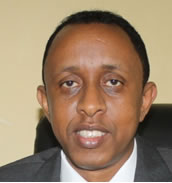by Mohamed Mukhtar
Thursday, February 2, 2017
 |
Prior to oil exploration, the geology of Somalia fascinated geologists due to the existence of thick sedimentary cover. in the late forties and early fifties, an intense geophysical prospecting was carried out followed by seismic surveys on onshore Somalia. in the mid-fifties, Sinclair Corporation executed drilling exploratory oil wells in onshore southern Somalia. The drilled wells were either dry or manifested gas or oil shows. there were no discoveries with commercial viability. Agip drilled few.
In late fifties and sixties, Somalia led in exploration intensity in Africa. Amerada surveyed and drilled few wells in north Somalia. However, because of Somalia adopting socialism and joining the Soviet block, western companies stopped operating in Somalia in the seventies and came back again to do business in the 1980s and that is when Somalia started opening its market.
After the overthrow of President Siad Barre in 1991, Somalia experienced years of anarchy. And it was not until 2012, when a new internationally backed government was established and the country began to enjoy a measure of stability once more.
Offshore drilling is a relatively new phenomenon for the East African countries. Not long ago, the crustal structure along the offshore Somalian margin was one of the least explored areas in Africa. The only offshore geological information that existed prior to 2014 was limited to regional scale correlation of out dated geological and geophysical data.
In 2014 and 2015, the Federal Government of Somalia carried out offshore seismic surveys in Southern Somalia. The aim was to define and delineate the geological structure of the southern Somalia offshore, which lies near major discoveries of oil and gas on the East African margin. In 2015, Spectrum ASA undertook the acquisition of 2D seismic data offshore South Somalia. The total number of sail line acquired equates to 20,582.75 Km. The new acquisition has complemented 20,000 km of existing seismic that was acquired in 2014.
A group of researchers along the Ministry of Petroleum & Minerals of the Federal Government of Somalia studied the newly acquired seismic data, previously drilled oil and gas wells, regional gravity and magnetic data as well as the findings from source rock thermal maturity. This type of information is important for delineating areas of petroleum generation and for assessing the undiscovered petroleum resources of the study area.
The results of the data collected and interpreted in the study area indicate the existence of three major and important offshore sedimentary basins, namely: Hobbia Basin in the North, Qoriole Basin in the centre, and the Juba-Lamu Basin which extends southwards into Kenya. These sedimentary basins have sediment thicknesses of more than five kilometres and contain good source rocks, reservoir rocks, seals and traps necessary for large volumes of oil and gas to deposit. These basins are similar in scale and formation to those in the Rovuma basin offshore Mozambique that have been so productive in recent years.
One of the most frequently asked question is what is the time frame before oil dollars start flooding in? Putting aside the time needed to address the political, legal and security issues, it normally takes the following time frame to move the life cycle of a petroleum field up to production: Surveys that involve carrying out seismic studies take 2 years. 2 - 3 years goes into carrying out exploration and drilling. Once discovery happens then appraisal is required to evaluate the size of the field. Appraisal is capital intensive, time consuming and may require additional seismic investigation. An additional two to three years might be needed in this case. The next stage is moving to production, which needs planning, putting in place production wells and deciding the best route to export.
If Somalia is to benefit from its rich and untapped resources, it is important to have political stability, continuity of governance, a shared vision towards the petroleum sector development and commitment to achieve it, patience over the years of development and keeping the public expectations managed. We are starting the oil industry of Somalia in a time when everything about oil is in place and we can benefit from that wealth of experience.
Mohamed Mukhtar Ibrahim
Minister of Petroleum & Mineral Resources
Federal Government of Somalia
[email protected]